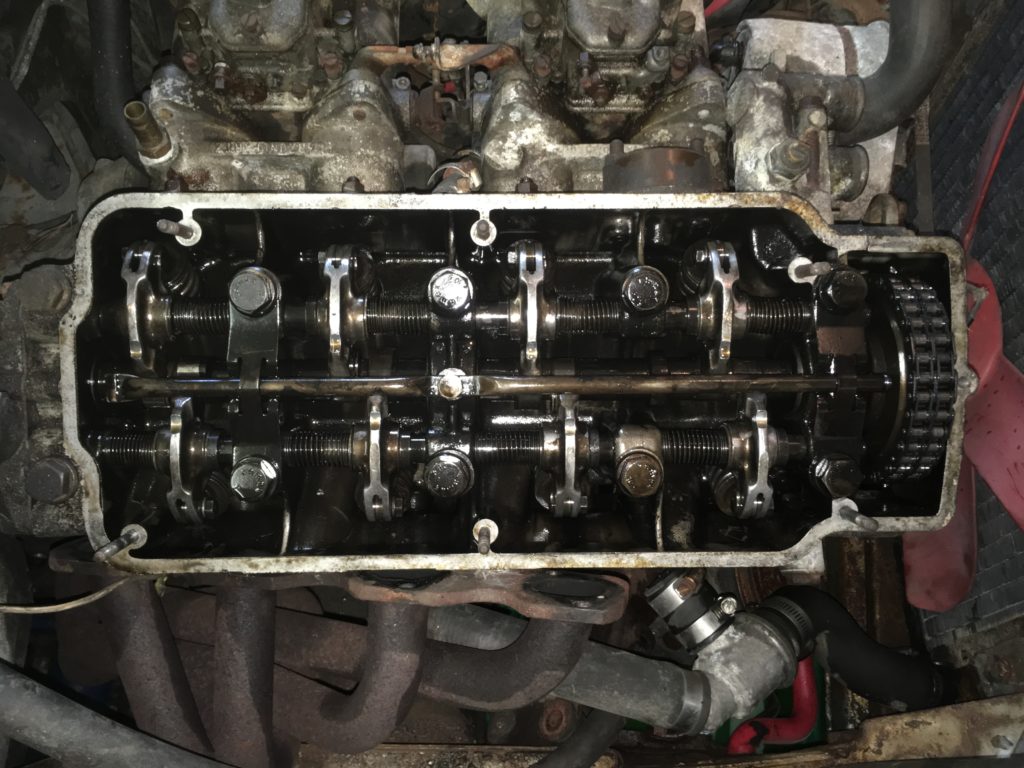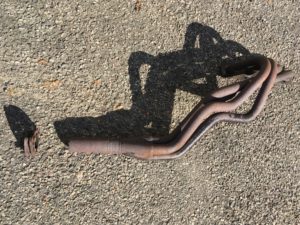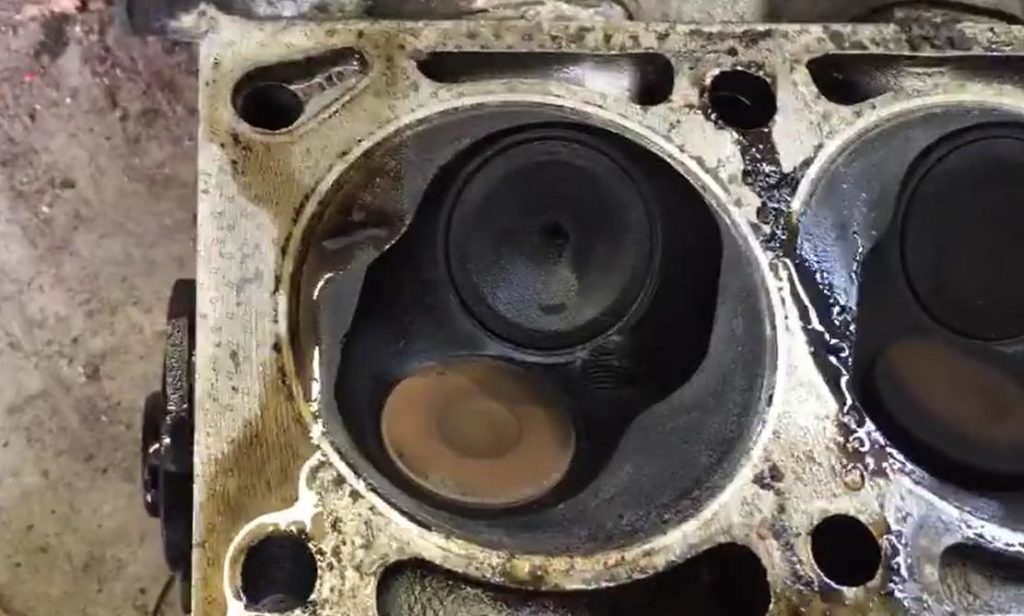Last week, I got Bertha—the 2002 I sold to my friend Alex nearly 30 years ago—running well enough to drive her out of the difficult-to-access garage where she had been languishing since she was stolen and recovered in 1992.
Alex has long said that the car seems to have suffered engine damage during the theft; he suspected that the engine had been over-revved and had floated a valve, which then bent when it met a piston. Indeed, poor running due to suspected engine damage was the reason Bertha had been pulled off the road and locked away all these years. And the bent-valve theory was consistent with the results of my compression test—which showed low compression in Cylinder #1—and a leak-down test, which showed that air was escaping from the #1 intake valve.
Although getting Bertha to the point where it could rise and drive out of its own tomb was enormously satisfying—and, let’s face it, entertaining—it really wasn’t much more than a stunt, albeit one born of necessity. I had bet—correctly—that even with one dead cylinder, I could get the car running and move it under its own power, which solved the problem of how to extract it from a rear-facing garage in a back yard with no driveway access; rather than set up a complicated cable tow, I simply drove the car out and up onto the street.
But it wasn’t as if I was then going to continue to drive it around that way. So when the car came home to my house in West Newton, after I gave it a cursory washing and interior cleaning, Job One was to pull the head.
Well, I should say that Job One was to get as much information as I could about why the #1 intake valve wouldn’t seal. I snaked a borescope down the spark-plug hole, but I didn’t see anything egregious, like a broken valve embedded in the piston crown or an errant nut holding the valve open.
It was time to decapitate Bertha.
To me, a big part of the joy of older cars like the 2002 is their simplicity. On a modern fuel-injected car, the amount of electronics and plumbing you need to remove simply to get to the point where the head can be pulled is daunting, but on a 2002, you undo the headpipe from the exhaust manifold, disconnect the throttle linkage and choke controls from the carb(s), pull the wire off the temperature sensor, loosen the hose clamps and pop off the hoses, yank the distributor, take out the timing-chain tensioner, undo the upper timing cover and pop off the cam gear, and you’re basically ready to remove ten head bolts and lift the head off.

Readying Bertha for decapitation.
Bertha did, however, suffer a casualty in this process. Part of the appeal of the car to me, in addition to the fact that Maire Anne and I drove off in it from our wedding, is the long list of 1980s modifications and parts from Roundel advertisers that I showered on it. One of those parts was a set of Headercraft exhaust headers; because of their length, they generally have to be removed before the head is pulled off (unlike an exhaust manifold, which can be left on). I could see that the center resonator to which the headers were bolted was rotted clean through, but the headers themselves looked all right.

The vintage Headercraft headers didn’t survive.
Unfortunately, when I began undoing the three seized bolts holding the headers to the resonator, instead of the bolt turning, the flange turned, and twisted right off the headers. The pipe was obviously weak there as well. For now, I’ll simply replace it with a conventional exhaust manifold and headpipe, but I may eventually see if I can get the Headercraft headers repaired.
A 2002 head isn’t particularly heavy, but as my decrepit body nears its sixtieth birthday, bending over and dead-lifting a head off a block is the kind of thing that angers up my back, so these days I position an electric winch over the engine and let it do the lifting. After the winch picked up the head, I swung the head down onto the fender where I could easily grab it, then laid it on a piece of cardboard on the garage floor. The video can be seen here.
First, I closely inspected the valves, particularly those in the #1 cylinder. I did not see anything that looked bent, but the #1 exhaust valve had a lighter appearance than the others, potentially indicating that it had been burning.

Close-up of apparently intact #1 intake and exhaust valve.
I then turned my gaze toward the block. I smiled when I saw the domes on the 10:1 Eurospec pistons that I’d installed in the engine (which was originally from a ’72 tii) over 30 years ago. But what I didn’t see was any indication that a valve had kissed a piston.

The pistons appear free of any indication of valve contact.
My friend George Thielen saw my Facebook post on the head removal and reminded me that it’s possible for valves and their seats to look good to the eye but still not seal, and that an easy way to check is to turn the head upside down and fill the combustion chamber with a light solvent. I put a spark plug back in the #1 hole, made certain that the cam was rotated so that both valves were closed, turned the head over, angled it so that the intake swirl chambers were as level as possible, filled the #1 swirl chamber with acetone, and smiled as I saw the fluid level in the chamber clearly drop as solvent drained out through the supposedly sealed valve seat.
Gotcha!
With that, I disassembled the valve train, knocking the shafts out and removing the rockers and the cam, and took the head, with the valves, guides, and springs still installed, to the local machine shop that does my work. A few days later, the machinist called, saying that he’d found one bad intake and one bad exhaust valve. Unfortunately, he hadn’t marked them before he cleaned them, so he couldn’t say which cylinder they were from. (He’s a practical guy. “People will tell you you need to put them back in the same place,” he said, “but it really doesn’t matter.”)
So, although Alex’s long-held “Engine was over-revved when Bertha was stolen and a valve was bent” theory appeared to not be supported by fact, Bertha’s engine did have damage that required the head to come off. But other than Alex’s memories of how the car ran 26 years ago, both before and after the theft, there was no way to know whether the non-sealing valves were a direct result of the theft or whether they were a consequence of the car’s having sat. As with so many “ran when parked” issues, after a certain point, the forensics don’t really matter much; what’s important is the condition the car is in now, and what needs to be done to it to fix what’s broken.
Two new valves are now at the machine shop. With luck, by next week’s post, Bertha will have her head back on, and I’ll be far enough along with other mechanical resurrection issues that the car can begin to limp up the driveway and down the street.—Rob Siegel
Rob’s new recent book, Just Needs a Recharge: The Hack MechanicTM Guide to Vintage Air Conditioning, is available here on Amazon. Or you can order personally inscribed copies through Rob’s website: www.robsiegel.com.





















